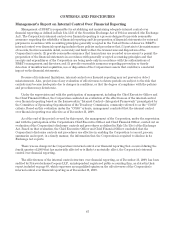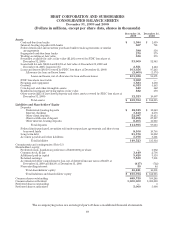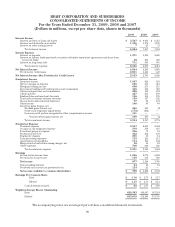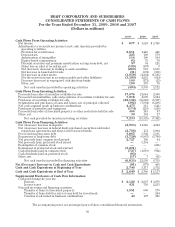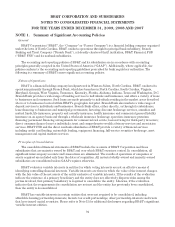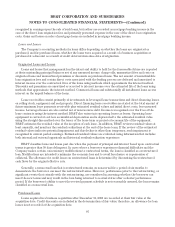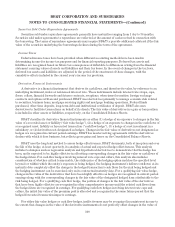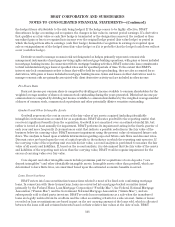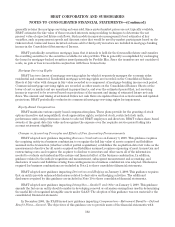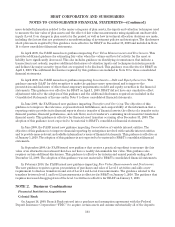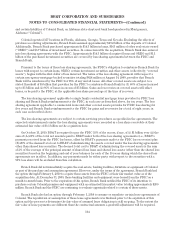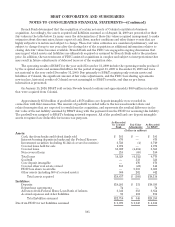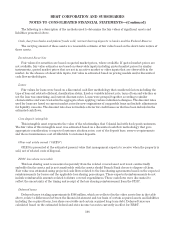BB&T 2009 Annual Report Download - page 97
Download and view the complete annual report
Please find page 97 of the 2009 BB&T annual report below. You can navigate through the pages in the report by either clicking on the pages listed below, or by using the keyword search tool below to find specific information within the annual report.
BB&T CORPORATION AND SUBSIDIARIES
NOTES TO CONSOLIDATED FINANCIAL STATEMENTS—(Continued)
recognized in earnings upon the sale of such loans, but rather are recorded as mortgage banking income in the
case of the direct loan origination fees and primarily personnel expense in the case of the direct loan origination
costs. Gains and losses on sales of mortgage loans are included in mortgage banking income.
Loans and Leases
The Company’s accounting methods for loans differ depending on whether the loans are originated or
purchased, and for purchased loans, whether the loans were acquired as a result of a business acquisition or
purchased at a discount as a result of credit deterioration since date of origination.
Originated Loans and Leases
Loans and leases that management has the intent and ability to hold for the foreseeable future are reported
at their outstanding principal balances net of any unearned income, charge-offs, unamortized fees and costs on
originated loans and unamortized premiums or discounts on purchased loans. The net amount of nonrefundable
loan origination fees and certain direct costs associated with the lending process are deferred and amortized to
interest income over the contractual lives of the loans using methods which approximate the interest method.
Discounts and premiums are amortized or accreted to interest income over the estimated life of the loans using
methods that approximate the interest method. Commercial loans and substantially all installment loans accrue
interest on the unpaid balance of the loans.
Lease receivables consist primarily of investments in leveraged lease transactions and direct financing leases
on rolling stock, equipment and real property. Direct financing lease receivables are stated at the total amount of
future minimum lease payments receivable plus estimated residual values and initial direct costs, less unearned
income. Leveraged leases are also carried net of non-recourse debt. Income is recognized over the lives of the
lease contracts using the interest method. BB&T also enters into operating leases as lessor. Operating lease
equipment is carried at cost less accumulated depreciation and is depreciated to the estimated residual value
using the straight-line method over the lesser of the lease term or projected economic life of the equipment.
BB&T estimates the residual value at the inception of each lease. In addition, BB&T reviews residual values at
least annually, and monitors the residual realizations at the end of the lease term. If the review of the estimated
residual values indicates potential impairment and this decline is other than temporary, such impairment is
recognized in current period earnings. Estimated residual values are evaluated using information that includes
both internal and external appraisals and historical residual realization experience.
BB&T classifies loans and leases past due when the payment of principal and interest based upon contractual
terms is greater than 30 days delinquent. In cases where a borrower experiences financial difficulties and the
Company makes certain concessionary modifications to contractual terms, the loan is classified as a restructured
loan. Modifications are intended to minimize the economic loss and to avoid foreclosure or repossession of
collateral. The allowance for credit losses on restructured loans is determined by discounting the restructured
cash flows by the original effective rate.
Generally, a nonaccrual loan that is restructured remains on nonaccrual for a period of six months to
demonstrate the borrower can meet the restructured terms. However, performance prior to the restructuring, or
significant events that coincide with the restructuring, are considered in assessing whether the borrower can
meet the new terms and may result in the loan being returned to accrual status after a shorter performance
period. If the borrower’s ability to meet the revised payment schedule is not reasonably assured, the loan remains
classified as a nonaccrual loan.
Purchased Loans
Loans acquired in a business acquisition after December 31, 2008 are recorded at their fair value at the
acquisition date. Credit discounts are included in the determination of fair value; therefore, an allowance for loan
losses is not recorded at the acquisition date.
97


